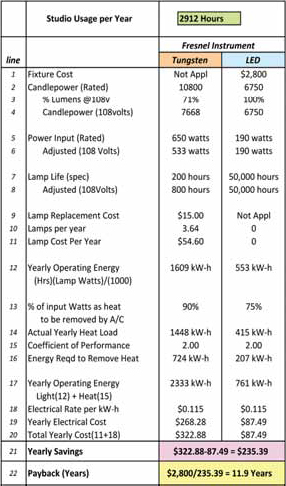Calculations to Justify a Retrofit, Part II

In my last column I reviewed some of the details of lighting instrument retrofitting with the intent of applying these details to the replacement of traditional tungsten filament lamps with fixtures containing solid-state lighting engines.
I suggested that filament lamps in a typical broadcast studio are never operated at rated voltage and, as a result, would exhibit a much longer lamp life than is usually applied in payback studies.
I would like to conclude this discussion by describing my approach to this subject.
SIMPLE METHOD
The method is quite simple. We will compare the yearly operating cost of two equivalent fresnel-lensed instruments: A traditional unit with a tungsten filament lamp and one with an LED source.
I will assume we know the replacement LED instrument will be much less expensive to operate and that we can easily calculate the operating savings— the difference in operating expenses between the two instruments.
To offset this gain we will have the initial cost of the new instrument. The Payback Period (in years) is this initial cost divided by the yearly savings due to be realized because of the more efficient performance of the new LED instrument.
As we are retrofitting, we assume that the tungsten filament instrument is already part of the studio’s lighting complement. The yearly studio usage was arbitrarily set at a reasonable 2,912 hours.
The professional video industry's #1 source for news, trends and product and tech information. Sign up below.
FINDING A REPLACEMENT
To facilitate the review of the elements of the method, the pertinent information and calculations are outlined in the table in Fig. 1. I selected a current well-designed LED fresnel fixture that is comparable to the popular 650-watt tungsten fresnel spotlight.
You will note that the candlepower of the two instruments (line 4) is the same order of magnitude. The candlepower of the tungsten unit is still a little greater than the LED unit even when operated at the suggested under-voltage value of 108 volts. This operating voltage was suggested last month as a good guess as to the average dimmer setting in a studio (about 8.5 points), a very conservative guess so as not to exaggerate the expected life.
The effect of operating at this voltage is reflected in the adjusted values of input power (line 6) and adjusted lamp life (line 8).
LAMP REPLACEMENT COST
The current purchase cost of the tungsten lamp has been entered in the table on line 9. Using the assumed studio yearly hours, two simple calculations are made: one determining the number of lamps to be used (line 10) and the second, calculating the total yearly lamp replacement cost (line 11). No replacement lamp cost is in the LED column as the estimated instrument life of the LED fixture is so great—50,000 hours or 17 years at the assumed studio usage.
As it is expected that the Payback Period will be appreciably shorter than this lamp life, LED lamp replacement will not be a factor.
Fig. 1: A comparison for replacing a tungsten fresnel with an LED fresnelDIRECT-ENERGY REQUIREMENTS AND COST
There are two significant items relative to a lighting fixture’s energy requirement. One is the direct power demand of the unit itself— expressed in watts—that the electrical power source will supply for the instrument’s operation. Line 6 shows these values for each instrument.

As the lighting output of each unit is approximately equal, this shows the higher efficacy of the LED unit. The yearly energy amount is then calculated by multiplying the operating wattage by the total yearly hours and is expressed in Kilowatt-Hours (kW-h). Line 12 displays this result.
HEAT REMOVAL
In addition, we must consider the cost of removal of the heat generated by our lighting instruments. Calculation of this cost is slightly more complicated than the calculation of direct energy cost.
Line 13 shows estimates of what percentage of the input power is produced as heat for each unit. The LED does produce less heat than the tungsten filament. Continuing, we produce the yearly energy heat load utilizing the yearly hour total (line 14).
Line 16 reflects the effectiveness of the air-conditioning system in removal of heat by applying something called the Coefficient of Performance (line 15). This educated estimate of 2.0 means that for every 1 kW-h supplied to the HVAC system, 2.0 kW-h of heat will be removed. It should be noted that, for simplicity, no reduction has been applied in attempting to accommodate for the number of regional cooling days.
METER READING AND TOTALS
Eleven-and-a-half cents per KW-h has been assumed to be the electrical rate. Adding the two power requirements determined above and adding the lamp cost per year (yes, $0.00 for the LED) and multiplying by this rate, gives the total electrical cost (line 20).
As anticipated, the operating cost of the tungsten lamp is appreciably more than the LED fixture. As was indicated in the first article, the labor cost of lamp replacement is not considered a significant issue and, as a result, has not been added to the operating cost of the tungsten instrument.
THE BOTTOM LINE
The Yearly Savings, the difference between each fixture type, is noted on line 21. The Payback Period is then calculated by dividing the purchase price of the LED fixture by the Yearly Savings. This is the time that the savings would need to accumulate to equal the cost of the retrofit.
The Payback Period is estimated to be 11.9 years. If the adjustments for lower-voltage operation of the tungsten unit were not applied, the Payback Period would be 6.2 years. The interpretation of these results is left to the reader.
Bill Klages would like to extend an invitation to all the lighting people out there to give him your thoughts atbillklages@roadrunner.com
